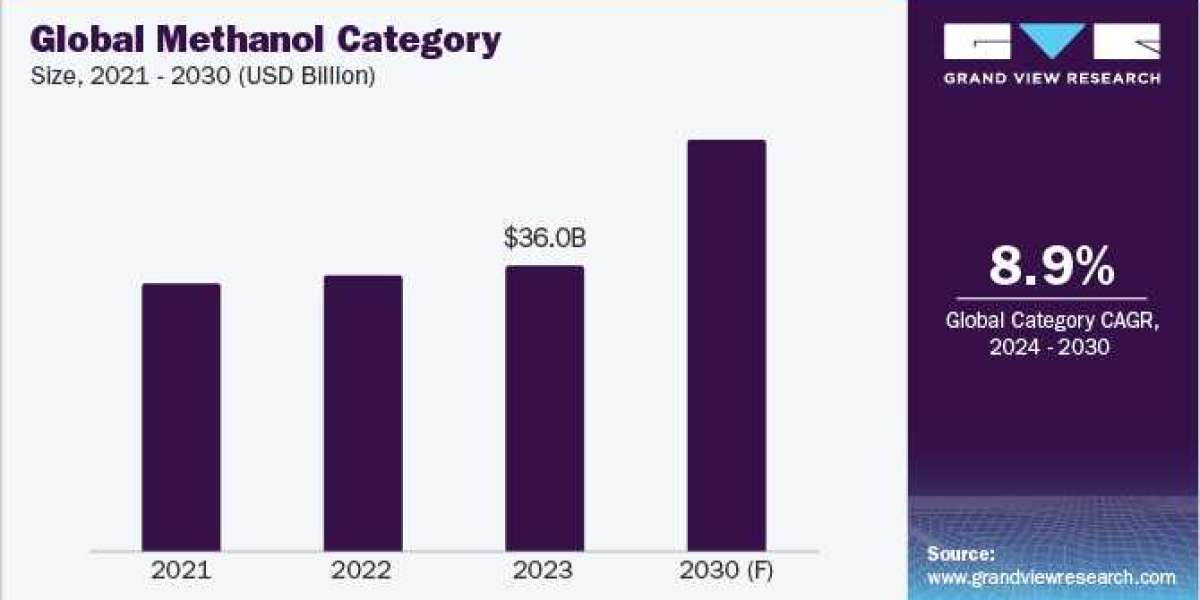Methanol Category - Procurement Intelligence
The methanol category is expected to grow at a CAGR of 8.9% from 2024 to 2030. Methanol is used as a fuel source due to its blending capacity and high-octane rating. Methanol, alternatively referred to as methyl alcohol or wood alcohol, is a transparent, lightweight, volatile, and combustible liquid possessing an aroma akin to ethanol or alcoholic beverages. It stands as one of the widely employed industrial chemicals, serving as a precursor in the manufacturing processes of formaldehyde, acetic acid, Methyl Tert-Butyl Ether (MTBE), Dimethyl Ether (DME), biodiesels, olefins, and various other compounds.
Methanol finds extensive application in the production of biodiesel, a biodegradable and environmentally safe alternative that generates fewer air pollutants compared to other fuels. Anticipated growth in the market is expected through government initiatives aimed at reducing the global carbon footprint. The category also plays a crucial role in olefins generation through the Methanol-to-Olefins (MTO) process, including key components like ethylene and propylene. These olefins have diverse applications, contributing to the production of synthetic rubber, synthetic plastic, pharmaceuticals, and textile dyes. Additionally, certain ethylene derivatives are employed in the manufacturing of ethylene glycol, vinyl chloride monomer, and vinyl acetate monomer, which are essential for various end-use industries such as paints, coatings, and adhesives. Rising demand for these products is expected to drive the consumption of methanol in manufacturing them, which is indirectly anticipated to boost the category growth.
Order your copy of the Methanol category procurement intelligence report 2023-2030, published by Grand View Research, to get more details regarding day one, quick wins, portfolio analysis, key negotiation strategies of key suppliers, and low-cost/best-cost sourcing analysis
Growing environmental concerns and the push for sustainable practices have led to an increased interest in green methanol production. Green methanol is produced from renewable sources, such as biomass, municipal solid waste, or captured carbon dioxide. This aligns with global efforts to reduce carbon emissions and promote a circular economy.
The methanol category is fragmented, with the presence of various players such as SABIC, Methanex, Proman, and OCI Global. These companies continuously focus on increasing their production capacity to meet the demand from the end-use industry, entering mergers and acquisitions, and entering into agreements for production in new locations to sustain in the market. For instance, in February 2023, Celanese and Mitsui Co. reached a consensus to extend their ongoing Fairway Methanol LLC joint venture, operating at Celanese’s Clear Lake U.S. facility, and extend the ownership till 2045. In the upcoming months in 2023, the Fairway Methanol LLC joint venture anticipates finalizing a cost-effective capacity expansion to 1.62 million metric tons. Additionally, later in 2023, the venture will commence recycled carbon dioxide (CO2) as an alternative feedstock for methanol production.
Methanol Sourcing Intelligence Highlights
- Buyers in the category include chemical manufacturing, energy, and automotive companies, which may have moderate to high bargaining power. This depends on the availability of alternative sources and the uniqueness of the methanol applications. Large buyers with significant purchasing volumes may have more bargaining power.
- Companies compete among themselves by increasing production capacity, entering into mergers and acquisitions to increase their global presence, and focusing on moving towards the production of green methanol.
- Raw material (natural gas, coal), labor, energy, equipment costs, transportation, and others are some of the cost components in the category. Other cost considerations include repair and maintenance, legal, and packaging costs.
- China, Saudi Arabia, and Trinidad and Tobago are the preferred countries for sourcing methanol due to their production capacity, availability of abundant feedstock (natural gas, coal), and availability of cheap labor.
List of Key Suppliers
- SABIC
- Methanex
- Proman
- OCI Global
- Mitsui Co.
- Celanese
- Simalin
- BASF
- Mitsubishi Gas Chemical
- Petronas
Browse through Grand View Research’s collection of procurement intelligence studies:
- Disposable Medical Gloves Procurement Intelligence Report, 2023 - 2030 (Revenue Forecast, Supplier Ranking Matrix, Emerging Technologies, Pricing Models, Cost Structure, Engagement Operating Model, Competitive Landscape)
- Cyber Security Procurement Intelligence Report, 2023 - 2030 (Revenue Forecast, Supplier Ranking Matrix, Emerging Technologies, Pricing Models, Cost Structure, Engagement Operating Model, Competitive Landscape)
Methanol Procurement Intelligence Report Scope
- Methanol Category Growth Rate : CAGR of 4.6% from 2023 to 2030
- Pricing Growth Outlook : 3% - 4% increase (Annually)
- Pricing Models : Volume-based pricing, competition-based pricing
- Supplier Selection Scope : Cost and pricing, past engagements, productivity, geographical presence
- Supplier Selection Criteria : Purity and grade of the product, end-use served, production capacity, bulk purchase quantities, delivery option, safety and environmental compliance, location and presence of supplier, and others.
- Report Coverage : Revenue forecast, supplier ranking, supplier positioning matrix, emerging technology, pricing models, cost structure, competitive landscape, growth factors, trends, engagement, and operating model
Brief about Pipeline by Grand View Research:
A smart and effective supply chain is essential for growth in any organization. Pipeline division at Grand View Research provides detailed insights on every aspect of supply chain, which helps in efficient procurement decisions.
Our services include (not limited to):
- Market Intelligence involving – market size and forecast, growth factors, and driving trends
- Price and Cost Intelligence – pricing models adopted for the category, total cost of ownerships
- Supplier Intelligence – rich insight on supplier landscape, and identifies suppliers who are dominating, emerging, lounging, and specializing
- Sourcing / Procurement Intelligence – best practices followed in the industry, identifying standard KPIs and SLAs, peer analysis, negotiation strategies to be utilized with the suppliers, and best suited countries for sourcing to minimize supply chain disruptions








